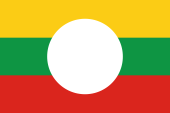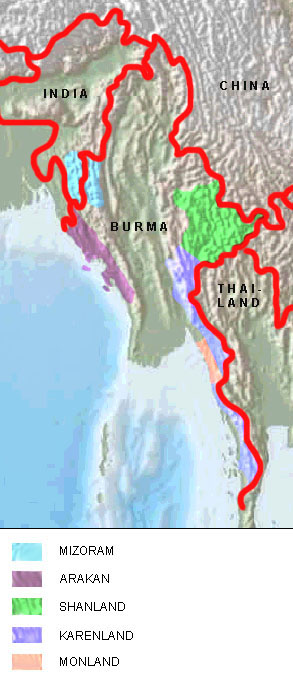mobile View, to the German Version tap the flag


- Shanland (Shan State, Shan States)
- semi-autonomous state in Burma with strong secessionist tendencies
• Flag
• Meaning/Origin of the Flag
• Map
• Numbers and Facts
• History
• Origin of the Country's Name

National flag,
ratio = 2:3(?),
Source, by: Flags of the World




On www.shanland.org (by now a private blog) the following description of the flag was allegedly found: The white disc represents the moon, it stands for purity and love of peace. The yellow stripe is the colour of Buddhism, the dominant religion of the Shan, green represents the evergreen mountain plateaus and agriculture, and the red stripe stands for bravery and courage. The flag was officially adopted for the Shan State on 12th of February in 1947. The flag is curiously similar to the flag of Burma, which was granted independence under the Japanese, as it was used between 1943 and 1945, but the white disc in the centre does not show a peacock.
Source:
Flags of the World,
Volker Preuß

clickable Map:

Source: Map is Freeware, University of Texas Libraries,
modyfied by: Volker Preuß

Area: 60.155 square miles
Inhabitants: 5.824.500 (2014), mostly Shan (Tai), furthermore Pa-O, Intha, Lahu, Lisu, Taungyo, Danu, Palaung, Ahka, Kachin (Jingpo)
Religions: 82% Buddhist, 10% Christian, 6% Animist, 1% Muslim
Density of Population: 97 inh./sq.mi.
Capital: Taunggyi, 381.639 inh. (2014)
Languages: Shan (Tai), Burmese, Chinese
Currency 1: Burmese Currency
Currency 2: 1 Renminbi Yuan (RMB, CNY, RMB¥, CN¥) = 10 Jiao = 100 Fen
Time Zone: GMT + 6,5 h
Source:
Wikipedia (EN)

11th to 13th century · immigration of the Shan, nascence of the Shan Empire under Chinese supremacy
1531 · invasion of the Burmese, disintegration of the Shan Empire in partly from Burma, partly from China dependant smaller states
1885 · British conquest
1937 · on the occasion of the detachment of Burma from British-India Shanland became Burmese
1942–1943 · occupied by Japanese troops
1943–1945 · Japan grants Burma independence, but the country remains occupied by Thai troops
4th of January 1948 · independence of Burma from United Kingdom, onset of civil war
from 1990 · strong Chinese immigration, growing Chinese influence, the regions of Wa and Kokang changed from Burmese currency to Chinese Yuan and switched to Chinese standard time
2008 · new constitution in Burma, Shanland (the Shan State) is partially given the status of an autonomous region
Supplement
The Shan belong to the Thai ethnic group. They invaded Upper Burma from China between the 11th and 13th centuries and founded the Shan Empire, which remained under Chinese sovereignty until 1531. Under the attacks of the Burmese under King Jabinshweti, the Shan disintegrated into many small principalities that exist to this day, most of which became dependent on Burma (also: Empire of Ava) or also on China. All the Shan states became tributary to China in 1769, and were ultimately conquered, colonised and annexed to British India by the British in 1886. The Shan were anything but enthusiastic about the separation of Burma from India and the eventual creation of the state of Burma, because the Burmese began - as in the centuries before - to exert massive influence in the Shan states, or to establish themselves as the dominant people in Burma. The federal structure of Burma also left a rather ambivalent impression on the Shan, so that powerful secessionist movements emerged among the Shan as early as 1947. Years of civil war and repression followed, and in the 1990s the Shan suffered several defeats at the hands of the Burmese army. Nevertheless, the Shan continue to fight for their rights as a people and a nation.
Source:
Atlas zur Geschichte,
Die Völker der Erde,
Wikipedia (EN),
Volker Preuß

The name "Shanland" has its roots in the Shan people. The denomination "Shan" is a summarizing word for the in Burma living Thai peoples. They call themselves Tai, Thai or even Yai-Tai. The word "Shan" goes back to the name of the dynasty which ruled the Shan-Empire between the 14th and the 16th century.
Source:
Die Völker der Erde,
Volker Preuß


![]()




